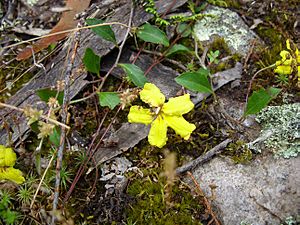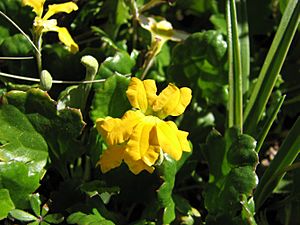Forest goodenia facts for kids
Quick facts for kids Forest goodenia |
|
|---|---|
 |
|
| Goodenia hederacea subsp. hederacea at Koorawatha Nature Reserve | |
| Scientific classification | |
| Genus: |
Goodenia
|
| Species: |
hederacea
|

The Forest Goodenia (scientific name: Goodenia hederacea), also known as Ivy Goodenia, is a pretty flowering plant. It grows only in eastern Australia, which means it is endemic to that area. This plant is a type of herb that can grow along the ground or stand upright. It has leaves that can be long and thin, oval, or round. Its flowers are bright yellow and grow in clusters.
Contents
What Does Forest Goodenia Look Like?
The Forest Goodenia is a plant that lives for many years. Its stems can grow up to 80 centimeters (about 31 inches) long.
Leaves and Flowers
- The leaves of this plant can be anywhere from 10 to 120 millimeters (about 0.4 to 4.7 inches) long.
- They are 3 to 25 millimeters (about 0.1 to 1 inch) wide.
- Each leaf has a stalk, called a petiole, that can be up to 40 millimeters (about 1.6 inches) long.
- The yellow flowers grow in long groups, called racemes, which can be up to 80 centimeters (about 31 inches) long.
- Each flower sits on a small stalk up to 50 millimeters (about 2 inches) long.
- The flowers have special parts called sepals, which are 3 to 5 millimeters (about 0.1 to 0.2 inches) long.
- The main part of the flower, called the corolla, is 8 to 15 millimeters (about 0.3 to 0.6 inches) long. It often has soft, cotton-like hairs on its back.
- The lower parts of the corolla are 3.5 to 7 millimeters (about 0.1 to 0.3 inches) long and have small "wings" up to 2 millimeters (about 0.08 inches) wide.
- After the flowers, the plant produces an oval-shaped fruit. This fruit is a capsule, about 5 to 9 millimeters (0.2 to 0.35 inches) long.
How Was Forest Goodenia Named?
The Forest Goodenia was first officially described in 1794. An English botanist named James Edward Smith gave it its scientific name, Goodenia hederacea. He published his description in a scientific journal.
Different Types of Forest Goodenia
Later, in 1912, another scientist named Kurt Krause described a slightly different type of this plant. He called it a "variety." Then, in 1990, Roger Charles Carolin changed its status to a "subspecies." This means there are now two main types of Forest Goodenia:
- Goodenia hederacea subsp. alpestris
- Goodenia hederacea subsp. hederacea
These two subspecies have some small differences:
- Subspecies alpestris has stems that can grow roots from their joints. Its leaves have white, cottony hairs underneath, and their stalks are usually longer (15 to 30 millimeters). This type flowers from November to April.
- Subspecies hederacea does not grow roots from its stem joints. Its leaves have soft hairs when they are young, and their stalks are shorter (3 to 10 millimeters). This type mainly flowers from August to March.
Where Does Forest Goodenia Grow?
The Forest Goodenia typically grows in forests. You can find it in various types of soil. Its natural home stretches from the southeast part of Queensland down to Victoria in Australia.
Where Each Subspecies Lives
- The subspecies alpestris prefers cooler places. It grows in subalpine grasslands and woodlands. You can find it in areas south of Kiandra in New South Wales, and in the higher parts of the eastern mountains in Victoria.
Is Forest Goodenia Protected?
The subspecies Goodenia hederacea subsp. hederacea is currently considered to be of "least concern" in Queensland. This means that the Queensland Department of Environment and Science believes it is not at risk of disappearing.
Growing Forest Goodenia in Gardens
If you want to grow Forest Goodenia, it's a good choice for gardens. It likes a spot that gets some shade and stays a bit moist. This plant can grow in many different soil types. It is also tough and can handle frost and even snow!

